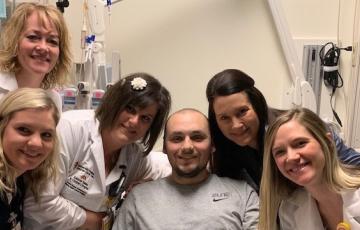Search Results
Another Option: Clinical Trials
A blood cancer diagnosis typically leads one to an oncologist or hematologist, a cancer center and a conversation about available treatment options. One option that is not always presented is that of being part of a research study.

A Starting Place to Prioritize Your Mental Health
Coping with a blood cancer diagnosis and the whirlwind of experiences that follows can be physically, mentally, and emotionally draining for everyone impacted by it.
Whether you're a patient or caregiver, you begin to realize your life will never be the same.

Champions in myeloma research, Part 2: A conversation with Suzanne Lentzsch, M.D., Ph.D.
To commemorate both Myeloma Awareness Month and Women’s History Month during March, I’ve been talking with LLS-funded women scientists who are driving discovery for myeloma patients. As we close out the month and my two-part series on myeloma researchers, I’m excited to share my recent conversation with Suzanne Lentzsch, M.D., Ph.D., Professor of Medicine and the Director of the Multiple Myeloma and Amyloidosis Program at Columbia University.

From office to Andes: LLS CFO takes the mission to new heights
JR Miller at Palomani Pass, the highest point on the Ausangate trek in Peru at 5,200 meters (17,060 feet)
After 25 years of service to The Leukemia & Lymphoma Society (LLS), JR Miller has seen the mission from nearly every angle – donor, volunteer, fundraiser, advocate, and executive. But this year, he added something new to that list: trekker.
Impact of Health Insurance on Mortality for Children and AYAs Newly Diagnosed with a Blood Cancer: A Population-Based Multistate Evaluation
Lacking continuous insurance is a key barrier to access to timely care. This study will provide the first evidence of whether insurance continuity provides a survival benefit, and how Medicaid expansion under the Affordable Care Act affects insurance continuity and the associated downstream changes in survival for children, adolescents, and young adults with blood cancers. This study will inform policy interventions toward increasing access and reducing disparities in blood cancer outcomes.
Why our health equity grants are more important than ever before
For 40 years, I’ve poured my life into fighting cancer. Working alongside doctors, nurses, social workers, researchers—and of course patients and their loved ones—we’ve made incredible progress.
But what keeps me up at night after all these years is the realization that, for too long, the health sector didn’t focus on the holes in that progress. As we collectively sprinted towards better treatments, we’ve left some patients behind.
A Day in LLS History
On October 20, 1944, Robert “Robbie” Roesler de Villiers was only 16 years old when he died from leukemia. Robbie’s parents, Rudolph and Antoinette, were stricken with grief and frustrated by the lack of effective treatments for what was then considered a hopeless disease.
After five years of mourning their son, they started a fundraising and education organization in his name. The Robert Roesler de Villiers Foundation had only a few volunteers and a tiny budget.

Why We Love Nurses (And You Should Too!)
It makes sense that at diagnosis and throughout treatment, someone diagnosed with a blood cancer will look around them for answers or support.
Acalabrutinib
Acalabrutinib is a kinase inhibitor indicated:
- In combination with bendamustine and rituximab for the treatment of adult patients with previously untreated mantle cell lymphoma (MCL) who are ineligible for autologous hematopoietic stem cell transplantation (HSCT).
- For the treatment of adult patients with MCL who have received at least one prior therapy.
- For the treatment of adult patients with chronic lymphocytic leukemia (CLL) or small lymphocytic lymphoma (SLL).
Doxorubicin
Doxorubicin is FDA approved to treat people who have some kinds of blood cancer, including acute lymphoblastic leukemia, acute myeloblastic leukemia, and Hodgkin and non-Hodgkin lymphoma.
Hydroxyurea
Hydroxyurea is FDA approved to treat people who have chronic myelocytic leukemia and some other blood cancers, including essential thrombocythemia and polycythemia vera. Hydroxyurea may cause temporary loss of hair in some people. After treatment has ended, normal hair growth should return, although the new hair may be a slightly different color or texture.
Methotrexate
Methotrexate is FDA approved, alone or with other drugs, to treat people who have acute lymphoblastic leukemia (ALL) that has spread to the central nervous system (CNS) or to prevent ALL from spreading to the CNS. It is also FDA approved to treat people who have advanced non-Hodgkin lymphoma and advanced mycosis fungoides. It may also be used to treat people with other types of blood cancer.
Omacetaxine mepesuccinate
Omacetaxine mepesuccinate is FDA approved for the treatment of adult patients with chronic or accelerated phase chronic myeloid leukemia (CML) with resistance and/or intolerance to two or more tyrosine kinase inhibitors (TKI).
The effectiveness of omacetaxine mepesuccinate was evaluated using a combined group of patients whose cancer progressed after previous treatment with two or more TKIs. All participants were treated with omacetaxine mepesuccinate.

Researchers Share Key Career Advice with LLS College Club Members
I recently had the privilege of moderating an LLS on Campus Researcher Panel attended by LLS college club members from nearly 30 universities across the country. These clubs bring together students interested in pursuing health-related careers and provide opportunities to hear from scientists working to better understand and treat blood cancers.
Topotecan
Topotecan is an FDA-approved cancer drug that is used to treat people who have certain types of cancer including acute myeloid leukemia and acute lymphoblastic leukemia. This drug may cause a temporary loss of hair in some people. After treatment with topotecan has ended, normal hair growth should return.
Palifermin
Palifermin is FDA approved to help prevent or lessen severe oral mucositis (inflammation of the mucous membrane of the mouth) in patients receiving certain types of blood cancer therapy.
